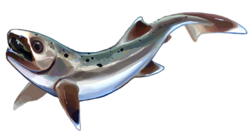Biology:Mcnamaraspis
| Mcnamaraspis | |
|---|---|

| |
| Artist's reconstruction of M. kaprios | |
| Scientific classification | |
| Domain: | Eukaryota |
| Kingdom: | Animalia |
| Phylum: | Chordata |
| Class: | †Placodermi |
| Order: | †Arthrodira |
| Suborder: | †Brachythoraci |
| Clade: | †Eubrachythoraci |
| Clade: | †Coccosteomorphi |
| Superfamily: | †Incisoscutoidea |
| Genus: | †Mcnamaraspis Long, 1995 |
| Species | |
| |
Mcnamaraspis is an extinct monospecific genus of arthrodire placoderm that inhabited the ancient reef system of north Western Australia during the Frasnian epoch of the Late Devonian period (c. 380-375 million years ago). The type specimen was found and described by John A. Long from the Gogo Formation near Fitzroy Crossing. This fossil fish showed new anatomical features in arthrodires, like the well-preserved annular (ring-shaped) cartilages of the snout, previously inferred to be present by Erik Stensiö of Sweden. It is occasionally referred to as "The Gogo Fish" after the locale the holotype was excavated from.
On 5 December 1995, the type species, M. kaprios, was officially proclaimed as the State Fossil emblem of Western Australia by the Governor of Western Australia, thus becoming the first official state fossil emblem for any state of Australia.[1][2]
Description
M. kaprios is an extinct marine fish that grew up to 0.5 m (1.6 ft) in length. With its large eyes, articulated jaw and sharp, razorlike dentition plates, it can be inferred that this midsize placoderm was an active predator that specialized in cracking through the shelled defenses of arthropods such as trilobites. It has a distinct cartilaginous snout not recorded in other placoderms.[1]
Phylogeny
Mcnamaraspis was originally classified as a member of the family Plourdosteidae.[3] However, phylogenetic analysis later found Plourdosteidae to be an invalid grouping, and the family was dismissed.[4][3] Mcnamaraspis is now considered to be a member of the superfamily Incisoscutoidea, which belongs to the clade Coccosteomorphi, one of the two major clades within Eubrachythoraci. The cladogram below shows the phylogeny of Mcnamaraspis:[5]
| Eubrachythoraci |
| ||||||||||||||||||||||||||||||||||||||||||||||||||||||||||||||||||||||||||||||||||||||||||||||||||||||||||||||||||
References
- ↑ 1.0 1.1 Long, J. (1995). "A new ploudosteid arthrodire from the Upper Devonian Gogo Formation of Western Australia". Palaeontology 38: 39–62. https://www.biodiversitylibrary.org/page/49766392#page/44/mode/1up.
- ↑ "The Fossil Emblem of Western Australia". Department of the Premier and Cabinet, Government of Western Australia. http://www.dpc.wa.gov.au/GuidelinesAndPolicies/SymbolsOfWA/Pages/FossilEmblemGogoFish.aspx.
- ↑ 3.0 3.1 You-An Zhu; Min Zhu (2013). "A redescription of Kiangyousteus yohii (Arthrodira: Eubrachythoraci) from the Middle Devonian of China, with remarks on the systematics of the Eubrachythoraci". Zoological Journal of the Linnean Society 169 (4): 798–819. doi:10.1111/zoj12089.
- ↑ Carr, R.K.; Hlavin, W.J. (2010). "Two new species of Dunkleosteus Lehman, 1956, from the Ohio Shale Formation (USA, Famennian) and the Kettle Point Formation (Canada, Upper Devonian), and a cladistic analysis of the Eubrachythoraci (Placodermi, Arthrodira)". Zoological Journal of the Linnean Society 159 (1): 195–222. doi:10.1111/j.1096-3642.2009.00578.x.
- ↑ Zhu, You-An; Zhu, Min; Wang, Jun-Qing (1 April 2016). "Redescription of Yinostius major (Arthrodira: Heterostiidae) from the Lower Devonian of China, and the interrelationships of Brachythoraci". Zoological Journal of the Linnean Society 176 (4): 806–834. doi:10.1111/zoj.12356. ISSN 0024-4082.
Wikidata ☰ Q21078608 entry
 |

